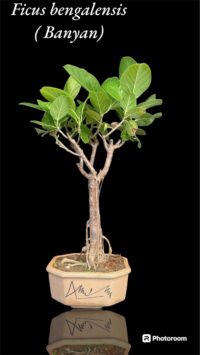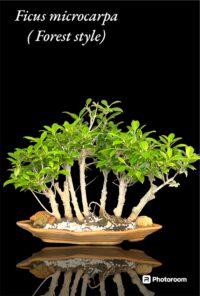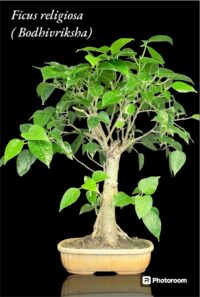Enhance your Banyan Bonsai Tree care-stunning results 2023
Banyan Bonsai Tree care
In this article we will explore the following Topics:-
Introduction to Banyan (Ficus bengalensis)
Banyan and Indian Mythology Connection.
Why is Banyan Bonsai most sought after?
Challenges in Making a Banyan Bonsai in 2023.
How to make Banyan Bonsai from Cutting in April Month in India
How to Make Banyan Bonsai in July Month in India.
Discuss the Primary and Final display Tray for Banyan Bonsai.
How to do Banyan Bonsai care.
How to induce ariel roots in Your banyan Bonsai.
How to save and develop hairy Ariel roots into thick ones.
Soil Maintenance, Fertilizing Watering, Pruning, Wiring, Insect Pest management.
Online Help and Hand holding resources.
FAQs.
Introduction to Banyan (Ficus bengalensis)
Banyan and Indian Mythology Connection.
The Fascinating Banyan: A Symbol of Growth and Resilience
If you’ve ever seen a banyan, you know it’s a sight to behold. With its impressive spread and multiple trunks, this type of fig tree is truly unique. But what makes it so special? In this article, we’ll explore the fascinating world of the banyan, its growth habits, and its cultural significance.
What is a Banyan Tree?
The banyan is a type of fig that grows in tropical and subtropical regions. Unlike others that grow upwards from a single trunk, the banyan spreads outwards and downwards, thanks to its adventitious prop roots. These roots grow from the tree’s branches and penetrate the ground, eventually developing into trunks themselves. This growth pattern allows the banyan to cover large areas and create dense canopies that provide shade and shelter for animals and humans alike.
Banyan Growth Habits.
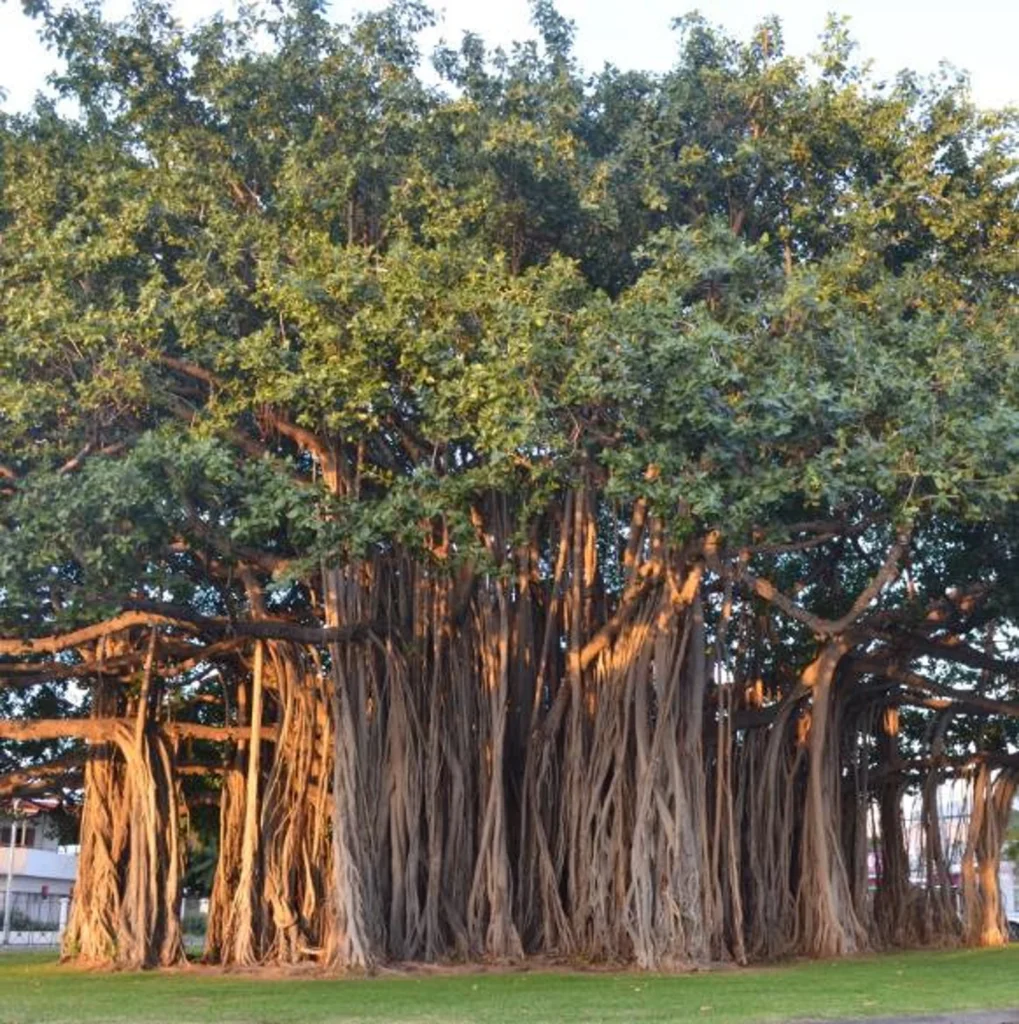
One of the most fascinating aspects of the banyan is its growth habits. As mentioned earlier, the tree’s adventitious prop roots allow it to spread outwards indefinitely. This means that a single banyan can cover several acres of land and have dozens of trunks. Some banyan trees are so large that they’ve been known to host entire villages under their canopies!
Another interesting fact about banyans is that they begin life as epiphytes. This means that their seeds germinate in the cracks and crevices of other trees or buildings. As the banyan grows, its roots wrap around the host tree or building, eventually strangling and killing it. The banyan tree then grows and develops its trunks and branches.
Cultural Significance of the Banyan Tree
The banyan has a rich cultural significance in many parts of the world. In India, for example, the banyan tree is the national tree and is considered sacred by Hindus. It’s believed that According to Hindu Mythology, Lord Vishnu is present in the bark of the Banyan tree, Lord Brahma is present in the roots of the Banyan tree and Lord Shiva is present in the branches of the Banyan tree. So the Banyan tree symbolizes Trimurti, and so the tree is often associated with new beginnings and fresh starts.
In Hinduism, the leaf of the Banyan tree is said to be the resting place for the god Krishna.
In Buddhism, the banyan tree is also an important symbol. This has led to the banyan tree being seen as a symbol of spiritual growth and enlightenment.
Why is Banyan Bonsai Tree is most sought-after &
Challenges in Making a Banyan Bonsai in 2023.
Banyan bonsai trees have been one of the most sought-after species of bonsai in recent years. The beauty and uniqueness of this tree make it an attractive option for both beginner and experienced bonsai enthusiasts. However, making a banyan bonsai tree can be quite challenging, and requires a lot of patience, skill, and knowledge. In this article, we will discuss why banyan bonsai trees are so popular and the challenges involved in creating one.
Why is Banyan Bonsai Tree the Most Sought-After?
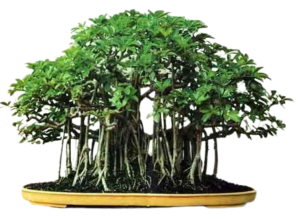
The banyan tree is native to India, and it is revered for its majestic appearance and the cultural significance it holds. In bonsai form, the banyan tree looks like a miniature version of a fully-grown banyan tree. The aerial roots of the banyan bonsai are its most striking feature. These roots grow downwards and spread outwards, creating a unique and intricate design. Additionally, banyan bonsai trees have glossy green leaves that add to their aesthetic appeal.
Another reason why banyan bonsai trees are so popular is their resilience. Banyan trees are known for their ability to adapt to various environments and climates. This makes them a great choice for bonsai enthusiasts who live in different parts of the world. With proper care and attention, a banyan bonsai tree can thrive in almost any setting.
Challenges in Making a Banyan Bonsai 2023
While banyan bonsai trees are beautiful, creating one can be quite challenging. The primary challenge is getting the aerial roots to grow downwards. This process can take several years, and it requires patience and skill. The roots need to be trained using wire and gradually lowered over time. Additionally, banyan bonsai trees need to be repotted regularly, and the roots need to be pruned carefully to prevent them from becoming too thick.
Another challenge in making a banyan bonsai tree is maintaining its shape. The aerial roots can grow quickly and become entangled, which can ruin the tree’s design. Regular pruning and maintenance are required to keep the tree’s shape intact. This requires knowledge and skill, and it can be quite time-consuming. During this Year 2023, the weather is very unpredictable, temperatures increased at the end of Feb 2023 only, and this sudden increase in temperatures made it difficult to decide the timing of Re-potting and pruning.
Increased rates of labour and transport have made the Banyan Bonsai material quite dearer, and it’s hard to find good banyan / barged at reasonable price in India.
In addition to these challenges, banyan bonsai trees require proper care and attention. They need to be watered regularly, and the soil needs to be well-draining. They also require proper fertilization, which is essential for their growth and development.
How to make Banyan Bonsai from Cutting in April Month in India
How to Make Banyan Bonsai Tree in July Month in India.
Here we will see the step-by-step process of making a Banyan Bonsai from cutting in April in India. This month is the best for preparing the cutting of any ficus variety of plant material. The process is also explained in the Video below:-
Step 1: Selecting a Cutting
The first step in making a Banyan Bonsai from cutting is to select a healthy cutting. Look for an older branch that is about 2 feet long and has several leaves and branches on it. The cutting should be taken from the parent plant in the early morning when the plant is not under stress. It is essential to use a sharp and sterilized tool to cut the branch.
Step 2: Preparing the Cutting
Once you have selected the cutting, remove the leaves from the lower half of the stem. Dip the cut end of the stem in a rooting hormone powder to promote root growth. Place the desired cutting in a container filled with sand or cocopeat. Water the soil thoroughly and place a plastic bag over the container to create a greenhouse-like environment effect.
Step 3: Caring for the Cutting
The cutting needs to be kept in a warm and humid place with indirect sunlight. Check the soil moisture regularly and water the soil when it starts to dry out. Avoid overwatering, as it can cause the roots to rot. After a month, you should see new growth of leaves on the cutting.
Step 4: Transplanting the Cutting
Once the cutting has developed roots, it is time to transplant it into a bonsai pot. Choose a pot that is the right size for the cutting and has good drainage. Fill the pot with well-draining soil and place the cutting in the centre of the pot. Spread the roots and cover them with soil. Water it soil thoroughly and place the pot in a warm and humid place with indirect sunlight.
Step 5: Pruning and Shaping of Banyan Bonsai Tree
As the cutting grows, it will need to be pruned and shaped to create a Banyan Bonsai tree. Regular pruning will help to keep the tree’s shape and size under control. Use wire to shape the branches and trunk of the tree, being careful not to damage the bark. It is important to be patient, as creating a Banyan Bonsai from cutting takes time and effort.
During the Month o July, the air layering is done on Bargad or Banyan Bonsais.
The Branch selection process and the rest of the procedure will be as above.
Discuss about the Primary and Final display Tray for Banyan Bonsai.
Now that you have fully developed the Cutting or Air-layered cutting of the desired shape.
After 2-3 years these are ready to be transferred to Bonsai Plates/trays from a regular pot.
The procedure for root cutting and transferring has been explained in the detailed video above.
Two types of trays exist for making big bonsai of the Banyan tree.
Cement Rectangular or square Pot and ceramic pot. Choose pot according to the tree.
Video of Banyan Bonsai Tree in a Ceramic Pot.
For Further Reading:-
Our Motto
What you see is what you get
Delivery
Personalised delivery at door step
Mission
Creating green spaces
How to do Banyan Tree Bonsai care.
How to induce Ariel roots in Your banyan Bonsai tree.
How to save and develop hairy ariel roots into thick ones.
Banyan Bonsai tree are similar to other Bonsai trees. Particularly Banyan bonsai trees are of a very hard nature and can survive very harsh climates like extreme summer draught an extreme cold conditions. The Banyan bonsai cannot tolerate snowfall and Frost on it so if you are living in such part of the world or in India where there are chances of snowfall it will be hard for The Banyan Bonsai to survive. If you really want to keep Banyan Bonsai in the snowfall area you must be ready to prepare a Greenhouse so that it can be saved from Frost.
We will discuss regular fertilization watering, soil preparation, and pruning root cutting, in the next section.
No Banyan Bonsai is ever complete without the presence of aerial roots. And this is the most difficult part of developing a Banyan bonsai tree, if you are living in hot and humid climatic conditions like West Bengal, Orissa Kerala and the Ghats of Maharashtra it is very easy to obtain aerial roads in your Banyan Bonsai , as you can get very hot and humid climate there and the aerial roots perfectly grow in these climatic conditions.
In the Northern Plains, the aerial roots do come out of the branches of the banyan bonsai tree but they are only in the rainy season or monsoon season when the climate is very hot and humid. They do not Fully in the Northern Plains and keeps on hanging in the air which would eventually dry in the coming months of September and October.
So if that is the case with you in your Banyan bonsai, it is advised that you put these small hairy aerial roots into a straw and touch it to the ground level of the bonsai tree so that they get a very hot and humid environment inside the straw and keeps on growing and eventually touching the soil.
Once the aerial root touches the soil it starts taking nutrition from the soil and start developing into thick one.
Soil Maintenance, Fertilizing Watering, Pruning, Wiring, Insect Pest management.
Online Help and Hand holding resources.
FAQs.
Selecting a Banyan Tree Bonsai:
Choosing the right banyan tree bonsai is the first step towards its care. When selecting a banyan tree bonsai, look for one that has a thick trunk and a well-established root system. The trunk should be straight and have a good taper, while the roots should be evenly distributed throughout the soil. Delhi Bonsai has a wide selection of banyan Bonsatreesee to choose from. The team remains with you while the whole process of Bonsai making and its care and maintenance. Whatsapp 9999788064 or comment below if you have been any help.
Planting the Banyan Tree Bonsai:
Once you have selected your banyan tree bonsai, it’s time to plant it. Fill a pot with well-draining soil and place the bonsai in it. Make sure that the roots are covered with soil and gently press the soil around the plant to ensure that it’s secure. Water the bonsai thoroughly and let it drain before placing it in a location with ample sunlight.
Watering:
Watering is essential for the banyan tree bonsai’s survival. Water the plant regularly, Banyan Bonsai does not mind over-watering at all. Also, ensure that the pot has adequate drainage to prevent water from pooling around the roots.
Fertilizing:
Fertilizing is crucial to the banyan tree bonsai’s growth and development. Use a balanced fertilizer every six months during the growing season. It’s best to use any vermicompost fertilizer diluted with water to avoid burning the plant’s roots. During the winter months, reduce the frequency of fertilizing.
Pruning and Wiring:
Pruning and wiring are essential for shaping the banyan tree bonsai’s growth. Prune the plant during the growing season to remove any dead or unwanted branches. Wiring can be used to shape the bonsai’s trunk and branches. Be gentle when wiring the plant to avoid damaging the bark. This has been discussed on other blogs, you can have a look here.
Repotting:
Repotting is necessary when the plant outgrows its pot or when the soil becomes depleted. Repot the banyan tree bonsai every two to three years in the spring. Remove the plant from its pot and trim the roots before repotting it in fresh soil. It has been shown in the video in the above section. Please refer
Pest Control:
Pests can cause significant damage to the banyan tree bonsai. Regularly inspect the plant for any signs of pests such as spider mites, mealybugs, and scale insects. If you notice any pests, remove them or use a natural insecticide like neem oil, also mix neem cake in the soil.
FAQS
- How often should I water my banyan tree bonsai? Answer: Water your banyan tree bonsai when the top inch of soil feels dry to the touch.
- How do I fertilize my banyan tree bonsai? Answer: Use a balanced fertilizer for six months and during the growing season. It’s best to use a liquid fertilizer diluted with water to avoid burning the plant’s roots. During the winter months, reduce the frequency of fertilizing to once a month.
- When should I prune my banyan tree bonsai? Answer: Prune the plant during the growing season to remove any dead or unwanted branches. Be gentle when pruning to avoid damaging the bark.
- How often should I repot my banyan tree bonsai? Answer: Repot the banyan tree bonsai every two to three years in the spring. Remove the plant from its pot and trim the roots before repotting it in fresh soil.
- What pests should I watch out for when caring for my banyan tree bonsai? Answer: Regularly inspect the plant for any signs of pests such as spider mites, mealybugs, and scale insects. If you notice any pests, remove them manually or use a natural insecticide. Banyan Bonsais or Banyan Trees are not generally prone to Insect and pests.
